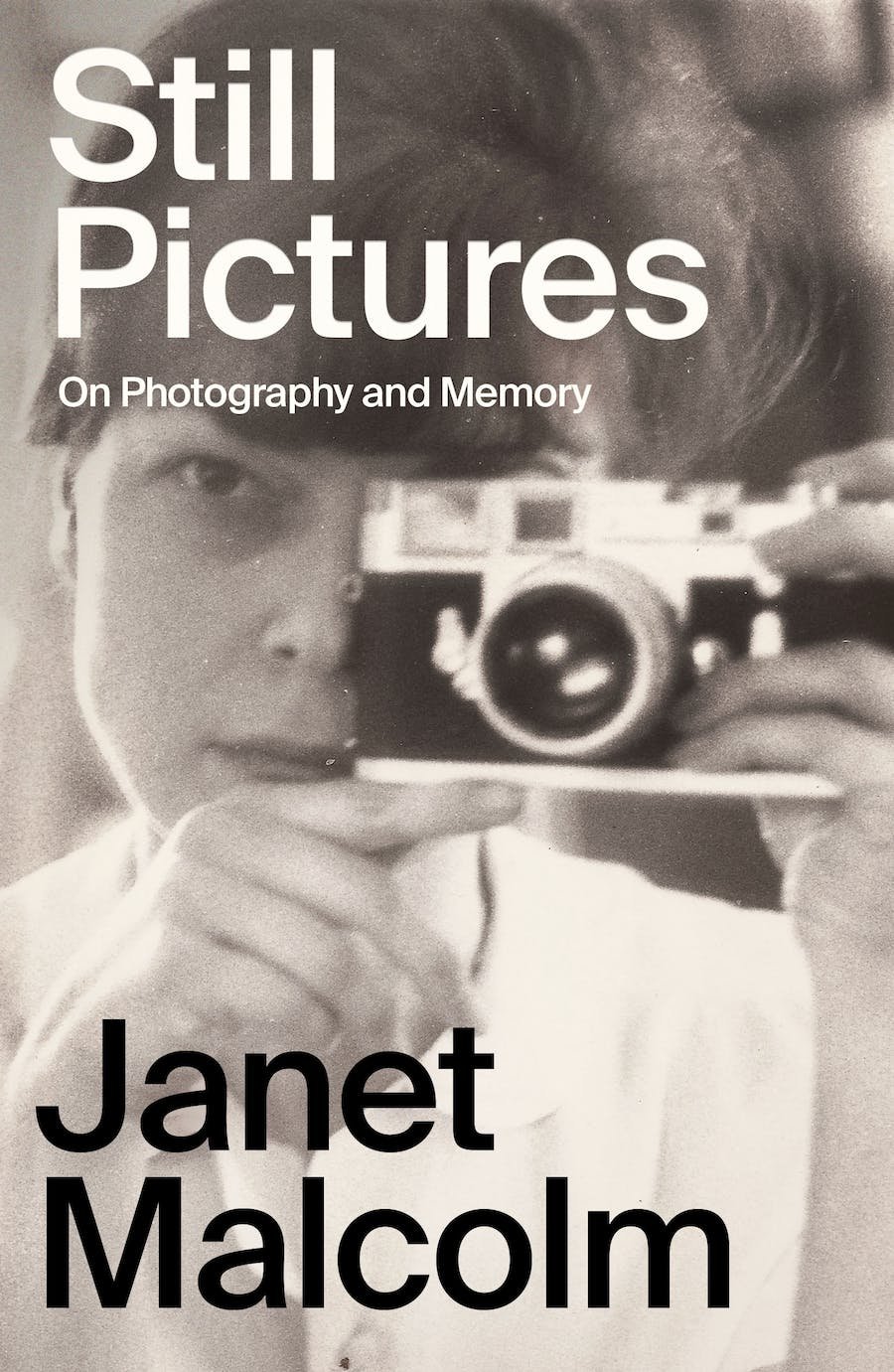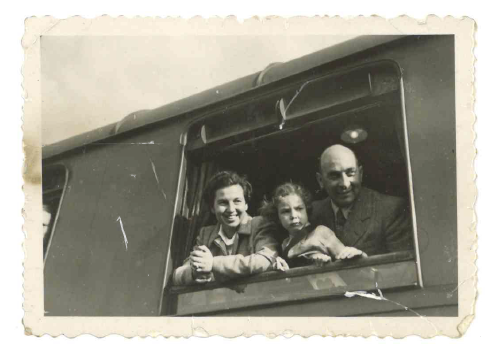
NO ONE KNOWS why they remember anything. Even the details of a disaster, like your time as a hostage, or the hurricane that swept away your house, may be shrouded in protective amnesia, while you can precisely describe the insignia on a set of buttons you saw when you were four. As Janet Malcolm puts it in her posthumous memoir, Still Pictures: On Photography and Memory, “The past is a country that issues no visas. You can only enter it illegally.”
Malcolm died of lung cancer in 2021, at the age of eighty-six. She left behind a gorgeous book and a weird book, and as you read it, you don’t know why she decided to write about this seemingly trivial moment growing up, or that couple rather than this other couple who were friends of her parents and fellow Czech escapees from Hitler. You don’t care why. Malcolm’s family was able to leave Prague in 1939 by bribing an SS officer with enough money—according to the story—to buy a racehorse.
Still Pictures is arranged as a series of prompts from photos that look grainy or unexceptional in other ways and have no meaning except to Malcolm. They are windows she looks through and doors she passes through to find herself drawn, again and again, to the clothes, food, and housing arrangements of these dislocated Jews, saved from death and sprung loose from a Europe where they were young and chic. In New York, where Malcolm’s family settles, they are modest and bourgeois—her father is a doctor—because that is their sense of how to fit in.
The memories arranged here are congenial, even when offered at the end of a knife, like a piece of apple. In many of Malcolm’s books—In the Freud Archives (1984), The Journalist and the Murderer (1990), and The Silent Woman (1992) among them—she’s a jackal on the hunt for some kind of fakeness, some kind of grandstanding, some kind of self-promoting flamboyance, some kind of crybaby blaming. Here, she doesn’t want to dislike anything. She wants to find pleasure, and the pleasure she finds is mainly in the way she uses language. As you follow her thoughts, you find less a world you can clip together from the fragments she lays out than the witty narrator herself, who has been gentled in some way and finds herself amused by life.
There are dozens of passages I could have picked out that are as moving or sharp or funny or reflective of the world Malcolm grew up in as these I’ve gathered. Malcolm writes in two time frames, lending the book its coherence and intimacy. The narrator is looking back and trying to evoke the feelings and thoughts of the creature she once was, and at the same time, the narrator is conveying how the memories are making her feel now, in the moment of talking to us.
About her first vivid memory, in fourth grade, she writes, “A classmate named Jean Rogers slid into a seat next to me and asked if I would be her best friend. Until this time, I had no friends. What Jean Rogers said made me happier than perhaps I had ever been. That her overture had been completely unexpected and unsolicited only heightened its powerful effect on me.”
Conjuring the movie Casablanca, she joins the chorus of women who, for decades, have screamed at the screen, Don’t ditch Bogie!:
Do you remember the noble Czech resistance leader played by Paul Henreid? That this paragon was Czech rather than Polish or Hungarian or from any other Nazi-occupied country is a reflection of the high regard in which Czechoslovakia was held in the Allied World of 1942. Today, no one in their right mind can stand this self-satisfied sap or understand why Ingrid Bergman chooses him over Humphrey Bogart. It is to my credit and to my sister’s that we couldn’t stand most of the Czechs in our parents’ circle of émigrés.
On her sense of yearning:
. . . the habit we form in childhood, the virus of lovesickness that lodges itself within us, for which there is no vaccine. We never rid ourselves of the disease. We move in and out of states of chronic longing. When we look at our lives and notice what we are consistently, helplessly gripped by, what else can we say but ‘me too.’
On a girl crush she has in her teens:
When I say I was in love with her, I am speaking from later knowledge. At the time—the late nineteen-forties—girls in love with other girls didn’t recognize what was staring them in the face. They—we—thought you could be in love only with boys. Lesbianism was something you only heard about. There was a book called The Well of Loneliness, a forbidden, rather boring text, from which we formed the idea of lesbians as unhappy, jodhpur-wearing daughters of fathers who had wanted sons.
IN 2007, MALCOLM published Two Lives: Gertrude and Alice, a book about Gertrude Stein and Alice Toklas. In the vagaries of Stein and Toklas on how they survived the war in France, in the ways they could misplace their Jewishness when convenient and, in Toklas’s case, her Jew-for-Jesus conversion to Catholicism in the 1950s (with the hope of meeting Stein again in heaven—don’t ask), you would think that Malcolm, the slayer of liars, would have found ample cause to hunt for blood. But a funny thing happens to her on the way to the kill: she falls in love with Stein and Stein’s powers of self-invention.
Up to this time, Malcolm has been in the habit of ranking forms of art as if they are members of a feudal society, with imaginative fiction and painting as the lords of the manor and journalism, photography, and biography the serfs harnessed to plows or begging around the gates. In the company of Stein, these categories begin to lose their sharp edges for Malcolm. The combination of pluck, courage, and luck in Stein’s story excites her. She marvels at the freedom Stein rips open for language, detaching it from lockstep syntax and determinacy. She cheers the naked appetite of Stein’s self-celebration, especially in The Autobiography of Alice B. Toklas, where, Malcolm says, Stein subverted the whole enterprise of autobiography by “dispensing with the fiction of humility” and rejecting what Malcolm calls “the flaccid narrativity of biography” in favor of “the bracing storylessness of human life.”
In everyone’s life, there is a dog whistle, but in each of us, the run is back to a different place.
By “the bracing storylessness of human life,” Malcolm means plot. She means the defiance of teleological readings of a life where, because a person has moved in a certain direction, you look back retrospectively to see a pattern of causes that were more or less inevitable. It’s as if for Still Pictures, Malcolm has adopted Stein’s ethos, seeing memory not as a key to unlocking a life but as a bunch of associations that grow around a backward glance without anyone having planted the seeds.
Toward the end of the book, Malcolm tells a rather shaggy-dog story about a dog that figured in her life and in that of her daughter when she was a very young child. Janet and her daughter, Anne, are remembering visits to Malcolm’s parents in the country in the 1960s. The dog belonged to friends of Malcolm’s parents and had been trained to run gleefully to anyone who whistled a particular tune. Anne had loved seeing the dog bounding down a path to greet her. Malcolm writes:
After telling the story, Anne whistled the tune herself—amazingly, it had remained in her memory all these years—and I immediately recognized it as the theme of Antonín Dvořák’s Slavonic Dances. The piece, an orchestral suite, is regularly played on WQXR, and I listen to it with mild boredom verging on irritation. But Anne’s whistling of the theme flooded me with emotion. I can’t exactly account for it—it seemed to act on me as it acted on the dog. It was as if the fifty-year-old ghosts of my parents, my child, and myself were calling to me from the shores of Lost Lake and I was helplessly responding.
In everyone’s life, there is a dog whistle, but in each of us, the run is back to a different place. A few chapters later, it hits me where Malcolm was running and perhaps why, and I will tell you my theory—although I dislike theory, especially the kind I am about to propose, which has a psychoanalytic tinge to it. More than a tinge, to be honest. I dislike what I find reductive in psychoanalytic theories, despite the comic tug on us at all times of our unconscious life and the ways it will surface at odd and inconvenient times, like the groundhog it is.
BEFORE I TELL you my theory, I need to tell you about the sudden appearance in the book of a long and detailed chapter concerning what is probably the most painful and taxing episode in Malcolm’s life: the ten-year period she spent tied up in a libel suit brought against her by Jeffrey Moussaieff Masson, the subject of In the Freud Archives (1984). Masson claimed a number of damning things Malcolm quoted him saying in her book were invented by her and did not come from his mouth. There were five passages in contention, and Malcolm had misplaced the notebook where she’d written down these statements. She’d taken notes by hand because she’d dropped and broken her tape recorder at the time of the interview. Many years after the trial took place, Malcolm’s granddaughter pulled down a red book from a bookcase, and in it were the lost handwritten notes. None of this evidence, which would have ended the lawsuits, was available, however, at the time of the trials.
Malcolm lost the first trial in 1993, although it was declared a mistrial because the jury was deadlocked in determining an amount Malcolm should pay Masson in damages—their views ranged from millions of dollars to nothing, and one juror suggested one dollar. There was a second trial a year later, and this time, Malcolm won. This chapter of Still Pictures is about how she pulled it off because of the the speech coach who helped transform her into a person jurors would like and therefore believe.

Malcolm writes with delicious enjoyment about how being an inducted member of The New Yorker corps, with its distanced stance in the world and its manner of patrician reserve, completely fucked up her appearance in court. She writes, “I was part of the culture of The New Yorker of the old days—the days of William Shawn’s editorship—when the world outside the wonderful academy we happy few inhabited was only there for us to delight and instruct, never to stoop to persuade or influence in our favor.” Masson’s lawyer wipes the floor with this approach, and the jury, as of course anyone would who is not one of “the happy few,” hates her.
She hires Sam Chwat for the transformation from “defensive loser” to the winner she will become. He advises she jettison her usual wardrobe of tweeds and somber colors and try to delight the jurors with bright scarves and a new, colorful outfit each day. Most importantly, she fights for herself. Her team guesses right that Masson’s lawyer will ask her the same questions as in the first trial, and this time, she’s prepared to talk a mile a minute, charging toward the points she wants to make, and to direct her testimony directly to the jurors, over the head and shoulders of her cross-examiner. Thanking Chwat near the end of the chapter, she writes, “His unspoken but evident distaste for The New Yorker posture of indifference to what others think and his gentle correction of my self-presentation at trial from unprepossessing sullenness to appealing persuasiveness took me to unexpected places of self-knowledge and knowledge of life.”
Where does it take her? It takes her to Gertrude Stein, you could say, or if you don’t want to say it, I will say it. It takes her to what she wrote about Stein “dispensing with the fiction of humility.” Where could such an idea have formed, if not from her own experience of the same thing at her second trial? Well, plenty of places, but allow me to connect these elements in her story. When Malcolm writes about Stein, she—atypically for a Shawn-inflected writer for The New Yorker—drops hints to the reader about the personal stakes in her appreciation of Stein, establishing her Jewishness by inserting untranslated Yiddish words such as meshugenah and goyim into her text and painting a thumbnail of her young self in New York as a peevish, affected creature looking for something to sting.
When I read the chapter on Sam Chwat, who was a very famous Henry Higgins to multitudes of movie stars wanting to shave their Brooklyn accents or add them, if they needed them for a part, and who was eulogized after his death in, among other places, the Jewish Telegraphic Agency, the shape of Malcolm’s book came flying up to me like a whistled-for dog. Sam had spoken to Janet, Jew to Jew. What style in the world could encapsulate goyish more than Shawn’s reserved, bemused, unruffled gestalt? Sam had given Janet her Jew back, and in her last book, she wrote not about herself but about the Jews who had made her, the Jews she wanted to hold against her, the Jews like her parents, her sister, and herself, who had “escaped the fate of the rest by sheer dumb luck, as a few random insects escape a poison spray.” In this book, Malcolm wanted more than anything to spend time with the people who made her feel things that can go to sleep until they are suddenly recalled to life.

